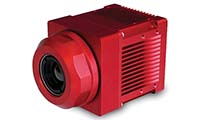Smart IR thermal imaging cameras for Industry 4.0
10/05/2019
 The new range of IRSX industrial infrared (IR) cameras from Automation Technology (AT) is designed to facilitate the use of thermal imaging in Industry 4.0 applications. Completely self-contained with embedded data processing, these compact, rugged cameras feature a multitude of interface protocols for direct communication with automation and control equipment. These include open platform communications unified architecture (OPC UA), a platform-independent open standard for machine-to-machine communication that is ideally suited to Industry 4.0.
The new range of IRSX industrial infrared (IR) cameras from Automation Technology (AT) is designed to facilitate the use of thermal imaging in Industry 4.0 applications. Completely self-contained with embedded data processing, these compact, rugged cameras feature a multitude of interface protocols for direct communication with automation and control equipment. These include open platform communications unified architecture (OPC UA), a platform-independent open standard for machine-to-machine communication that is ideally suited to Industry 4.0.With a choice of sensors (336 × 256 or 640 × 512 pixels), fields of view, frame rates and physical configurations, these new cameras can be used for autonomous thermal monitoring wherever temperature is a critical factor in the manufacture and processing of industrial products. Other applications include preventative early fire detection and plant condition monitoring.
A powerful user-friendly web interface provides access to a comprehensive range of software tools on the versatile embedded AT Vision World platform. These support the integration and use of the cameras and include sensor communication libraries and standard application programming interfaces (APIs), such as representational state transfer (REST), GigE Vision, message queuing telemetry transport (MQTT) and OPC UA, as well as a constantly growing number of application-specific apps. Solutions for thermal imaging applications can therefore be created easily and efficiently without the need for a PC or additional specialised thermal imaging software. This reduces system complexity, installation time and cost.
The IRSX series offers versatile integration and control capabilities. The cameras can be easily integrated into software projects using cxCamSDK. This provides a C-based API and language wrappers for C++, Python, MATLAB and Octave, as well as a generic interface based on the GEV/GenICam transport layer standard. The CxREST API defines an architecture approach based on World Wide Web (WWW) standards for communication between different systems in networks. This facilitates integration based on standardised methods such as hypertext transfer protocol secure (HTTPS), JavaScript object notation (JSON) or extensible markup language (XML).
The cameras feature a number of communication protocols for interfacing with external automation and control equipment, from the well-established Process Field Net (PROFINET) or Modbus transmission control protocol (TCP) to the newer OPC UA and MQTT. They also have digital inputs/outputs for control and alarming, as well as an encoder interface for part tracking on variable speed lines, for example. The OPC UA and MQTT protocols will play an important role in the Internet of Things (IoT) and machine-to-machine communication for Industry 4.0. Using OPC UA, the sender and receiver communicate directly; however, MQTT uses an intermediary known as an MQTT broker. Both protocols provide standardisation and high scalability.
The cameras are available in three model types to meet a wide variety of applications and installations. The ‘compact’ and ‘universal’ versions are supplied in rugged IP67 full-metal housings and can be installed on the factory floor, even in very small spaces, without any need for an additional protective enclosure. The compact version is designed for use with lenses that have a wide field-of-view, while the universal version is compatible with most lenses. An ‘open’ version without housing is also available. This can be fitted with a housing for a specific application by the customer. A housing integration kit can also be supplied.
A wide range of lenses is available for a host of thermographic applications. All lenses feature a large aperture for high radiation throughput and maximum utilisation of sensor sensitivity for high-quality thermal images. Customer-specific focal lengths, for example large ones for monitoring distant objects, are available on request.
www.stemmer-imaging.com